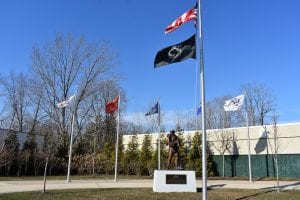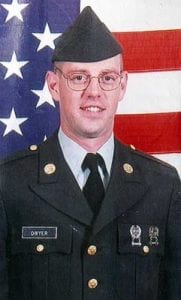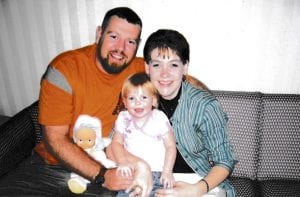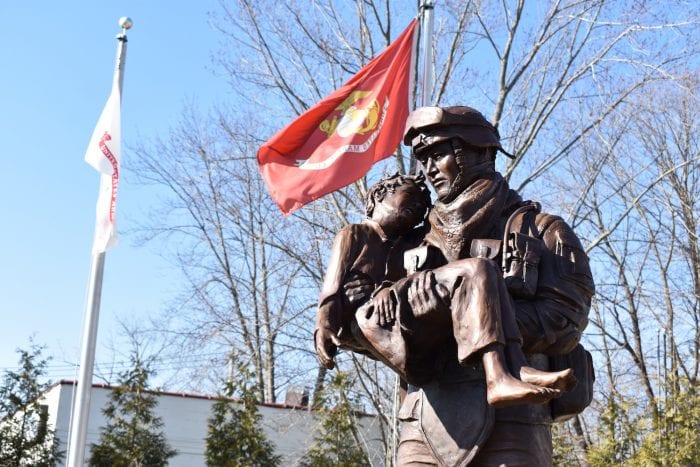New Statue Stands for Veteran Mental Health
By Rich Acritelli
Through these daunting times, the men and women in the Armed Services have always made this nation proud of their efforts to protect, preserve and promote the ideals of this nation at home and abroad.
Earlier this month, Tommy Fricke and his workers from Fricke Memorial added a tribute to the Rocky Point Veterans Square on the corner of Broadway and 25A — another reminder of national service to local residents — through the Combat Medic Joseph P. Dwyer Statue.
This statue of Dwyer identifies the terrible impact of post traumatic stress disorder on combat veterans that have returned home after being involved in serious fighting. Since 1915, this recognized brain trauma, from the impact of fighting on a soldier was identified as “shell shocked.”
There was no significant counseling that was offered by the government to properly treat millions of men and women from these different conflicts. Little was offered in therapy to the veteran that had fought over the skies of Europe, or who landed at D-Day, or through the island-hopping campaigns in the Pacific and Asia.
In many cases, veterans were told to forget about their experiences, go home, get married, attend college, find a job and start a family.

It is highly possible that many of the people who drive by the Dwyer Statue had family members who had no significant help to deal with PTSD. Some men and women had nightmares, outbursts, flashbacks and were in dire need of mental and physical attention that was not provided to them.
According to the Veterans Administration, the most recent Gulf War veterans that served during Operations Iraqi Freedom and Enduring Freedom have been inflicted from 11-20 veterans out of every 100. During Desert Storm, the figure is 12 out of every 100 veterans have suffered from PTSD.
And these numbers are staggering for Vietnam veterans, who at one point in their life had to deal with the enormous pressures of their service. It is estimated that at least 30% of Vietnam Veterans endured PTSD.
This new statue focuses on the strength of American service, and the responsibilities of our government to care for all the members of the Armed Forces when they return home.
As a child, Dwyer attended elementary school at Infant Jesus in Port Jefferson and graduated from Mount Sinai High School in 1994. As a young man, he enjoyed playing golf and going fishing with his friends and family. After he left high school, Dwyer moved to North Carolina with his parents and was employed at a local hospital where he transported people who needed medical treatment.
According to his older sister Kristine, Dwyer was a peaceful man who always wanted to care for others. When America was attacked on Sept. 11, 2001, after watching the assault on this nation, he tried to enlist that very day into the army but had to wait until Sept. 12. He eventually graduated from Basic and Advanced Individual Training from Fort Benning, Georgia, where he became a combat medic.
Shortly after finishing his training, Dwyer was sent to Fort Bliss, Texas, where he vaccinated soldiers that were deployed overseas. On Feb. 15, 2003, he married his sweetheart, Matina, in Troy, North Carolina.
When President George W. Bush (R) ordered American soldiers to be sent to the Middle East to attack Saddam Hussein and Iraq in 2003, Dwyer replaced a single mother, so that she was able to remain home with her child. He was one of the first soldiers to enter Iraq during this war with the 37th Cavalry Regiment.

While Dwyer told his family that he was being deployed to a hospital in Kuwait, they had no idea that he was with the leading army units that were on the road toward Baghdad — it wasn’t until the media began to run stories of his actions saving a child when they realized he was serving in Iraq.
This well-known picture of Dwyer carrying a young child to safety was published and reported across the nation, and around the globe. But to the day he died, Dwyer repeatedly stated that there was another combat medic that played a pivotal role in saving the life of this young boy.
It was a difficult deployment for Dwyer who was constantly under attack, lonely and unable to sleep. An exhausted Dwyer began inhaling computer cleaner Dust-Off to help him sleep a few hours before going back onto duty.
On June 20, 2008, Dwyer left Iraq and traveled alone to Fort Bliss to eventually meet his wife, where they set up their home. A month later, the couple headed back to Mount Sinai, where he enjoyed the reunion with his family, friends and teachers.
Right away, his sister realized that he was grossly underweight. He lost over 40 pounds during his time in Iraq. While Kristine cherishes the moment of seeing her brother after his deployment, she is not sure of his true joy, due to his unknown PTSD condition.
Once he was at home, Dwyer was continually impacted by the issues of his PTSD condition. There were points that when he was driving, that Dwyer feared possible unexploded ordinances that were on the roads. He never held the feeling of personal safety, had disturbing visions, and for the rest of his life, this peaceful man had no personal peace after he served in Iraq.
Kristine noticed a stare that developed in her brother who always wanted to be outside. Matina observed that her husband never liked going out to dinner, he closely watched the other customers, and always kept an eye on the door. Dwyer eventually gained his discharge from the service, but it was a battle to fight the government to receive his full disability compensation. During his service at home and when he left the army, Dwyer was still unable to sleep, and he continued to inhale Dust-Off.
By the end of his life in 2008, he did not have family members living with him and was unable to hold onto his own mental state.
The picture that was widely presented across the nation and in different parts of the world was indicative of the kindness of Dwyer, even as he dealt with the horrors of his own personal concerns.
Until he passed away, it was important for Dwyer to have his story truthfully reported that presented the negatives of PTSD, and how it drastically changed the mental state of this peaceful citizen. On June 28, 2008, Dwyer died from the inhalants that he used to cope with the severity of his PTSD.

In speaking about the memory of her husband, Matina firmly recalls how he always sought to help others with an immense amount of love. This affection was especially demonstrated to his then two-year-old daughter who was called his “little princess.”
Meagan K. Dwyer is now 14 years old with a memory that lives on through family stories and pictures of her father.
At the end of World War II, the historic Flag Raising at Mount Suribachi, Iwo Jima, was a similar picture that showed the resolve of American service overseas.
When Ira Hayes, a marine that hoisted this flag during the earliest moments of this terrifying battle, came home, he suffered from PTSD where he drank heavily and agonized over his fellow marines and friends that died on this island. A short time later, he died from excessive drinking.
Although Hayes passed away nearly 67 years ago, his story is connected to Dwyer. Both veterans were widely documented through a historic picture that rapidly received national acclaim from Americans across this country.
But the hardships of PTSD never discriminate from one soldier or conflict to the next, and it is vital for this government to always perfect its ways to help combat veterans.







